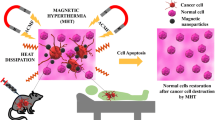Abstract
Background
Laser-interstitial thermal therapy (LITT) is an ablative treatment based on a surgically implanted laser-emitting catheter to induce a focal ablation of the pathological tissue. The main indications in neurosurgery are primary brain tumors, metastases, radiation necrosis, and pediatric brain tumors. Several approaches have been proposed to implant the laser-emitting catheter, both in frameless and frame-based conditions.
Methods
We report our approach for Robot assisted laser-interstitial thermal therapy of brain lesions with iSYS1 and Visualase (Medtronic).
Conclusions
iSYS1 represents a significant adjunct to LITT procedures and may be safely implemented in routine laser-catheter positioning.





Similar content being viewed by others
References
Ashraf O, Patel NV, Hanft S, Danish SF (2018) Laser-induced thermal therapy in neuro-oncology: a review. World Neurosurg 112:166–177
Fomenko A, Serletis D (2018) Robotic stereotaxy in cranial neurosurgery: a qualitative systematic review. Neurosurgery 83(4):642–650
Lagman C, Chung LK, Pelargos PE, Ung N, Bui TT, Lee SJ, Voth BL, Yang I (2017) Laser neurosurgery: a systematic analysis of magnetic resonance-guided laser interstitial thermal therapies. J Clin Neurosci. https://doi.org/10.1016/j.jocn.2016.10.019
Legnani FG, Franzini A, Mattei L et al (2019) Image-guided biopsy of intracranial lesions with a small robotic device (iSYS1): a prospective, exploratory pilot study. Oper Neurosurg (Hagerstown, Md) 17(4):403–412
Patel NV, Mian M, Jason Stafford R, Nahed BV, Willie JT, Gross RE, Danish SF (2016) Laser interstitial thermal therapy technology, physics of magnetic resonance imaging thermometry, and technical considerations for proper catheter placement during magnetic resonance imaging–guided laser interstitial thermal therapy. Neurosurgery 79(6):S8–S16
Patel P, Patel NV, Danish SF (2016) Intracranial MR-guided laser-induced thermal therapy: single-center experience with the Visualase thermal therapy system. J Neurosurg. https://doi.org/10.3171/2015.7.JNS15244
Pruitt R, Gamble A, Black K, Schulder M, Mehta AD (2017) Complication avoidance in laser interstitial thermal therapy: lessons learned. J Neurosurg 126(4):1238–1245
Salem U, Kumar VA, Madewell JE, Schomer DF, de Almeida Bastos DC, Zinn PO, Weinberg JS, Rao G, Prabhu SS, Colen RR (2019) Neurosurgical applications of MRI guided laser interstitial thermal therapy (LITT). Cancer Imaging 19(1):65
Acknowledgements
We thank Dr. Giovanni Carone for his help in mounting and editing the video.
Author information
Authors and Affiliations
Corresponding author
Ethics declarations
Conflict of interest
The authors declare no competing interests.
Additional information
Key points
1. LITT can be a viable option only for a limited number of patients due to its intrinsic limitations and to its indication still not universally agreed.
2. Robot assisted positioning might be indicated in those cases in which accuracy is particularly relevant.
3. Trajectory planning must respect the general rules of stereotaxy as well as the morphology of the lesion in relation to the shape of laser emission.
4. Several simulations are needed to find the best solution in regard to number of catheters and relative trajectories.
5. Skin fiducial-based registration offers a level of accuracy comparable to bone fiducials and better than surface match.
6. The metal bone anchor provides a better accuracy than plastic anchor and should be preferred, even if in superficial lesions, it could slightly interfere with thermometry MRI.
7. During robot-assisted positioning, in the effort to maximize the accuracy, two entry points have to be defined. The first is on the bone, to perform the drilling, while the second is on the extension of the trajectory (5cm away from the bone), to accommodate the bone-anchor under the guidance sheath.
8. Before initiating thermal ablation, it is extremely important to acquire an MRI scan to exclude potential errors in catheter positioning and complications occurrence (e.g., hematoma).
9. The entire workflow of the procedure must be proven and standardized. Ideally, the best setting is represented by a hybrid operating room with an intraoperative MRI.
10. Follow-up protocol should embrace multiple MRI scans acquired at the end of the treatment, 24h post, 1month post, and every 3 months. The aim is to assess edema evolution over-time, and the potential lesion relapse/progression. Perfusion-weighted images can help in distinguishing between post-treatment modifications and true relapse.
Publisher's note
Springer Nature remains neutral with regard to jurisdictional claims in published maps and institutional affiliations.
This article is part of the Topical Collection on Neurosurgical Technique Evaluation
Supplementary information
Below is the link to the electronic supplementary material.
Supplementary file1. Robot assisted Laser-Interstitial Thermal Therapy with iSYS1 and Visualase in a case of single left parietal brain metastasis from kidney. The patient underwent whole brain radiotherapy 20mos before treatment, the systemic disease was under control while the single brain metastasis had demonstrated continuous growth in 2 consecutive MRI. (MP4 156727 KB)
Rights and permissions
About this article
Cite this article
Casali, C., Del Bene, M., Messina, G. et al. Robot assisted laser-interstitial thermal therapy with iSYS1 and Visualase: how I do it . Acta Neurochir 163, 3465–3471 (2021). https://doi.org/10.1007/s00701-021-04883-3
Received:
Accepted:
Published:
Issue Date:
DOI: https://doi.org/10.1007/s00701-021-04883-3




